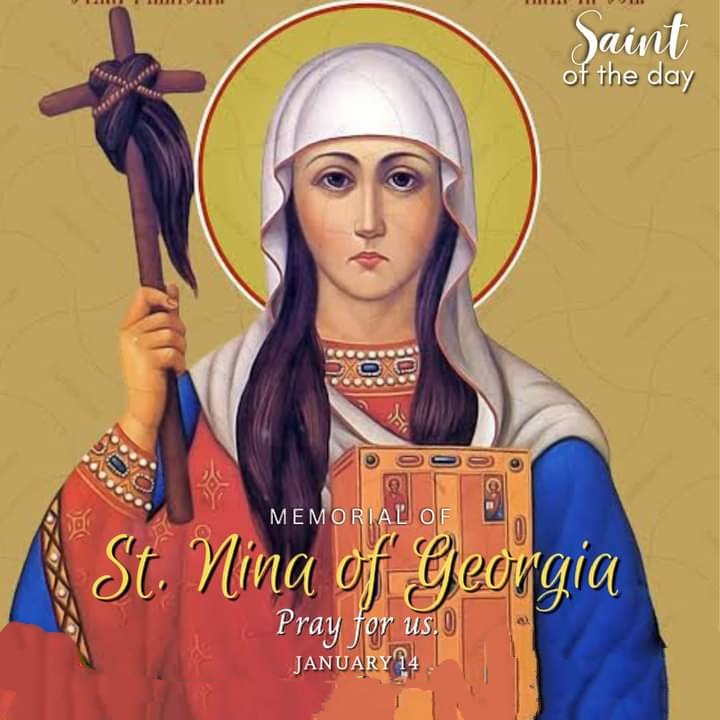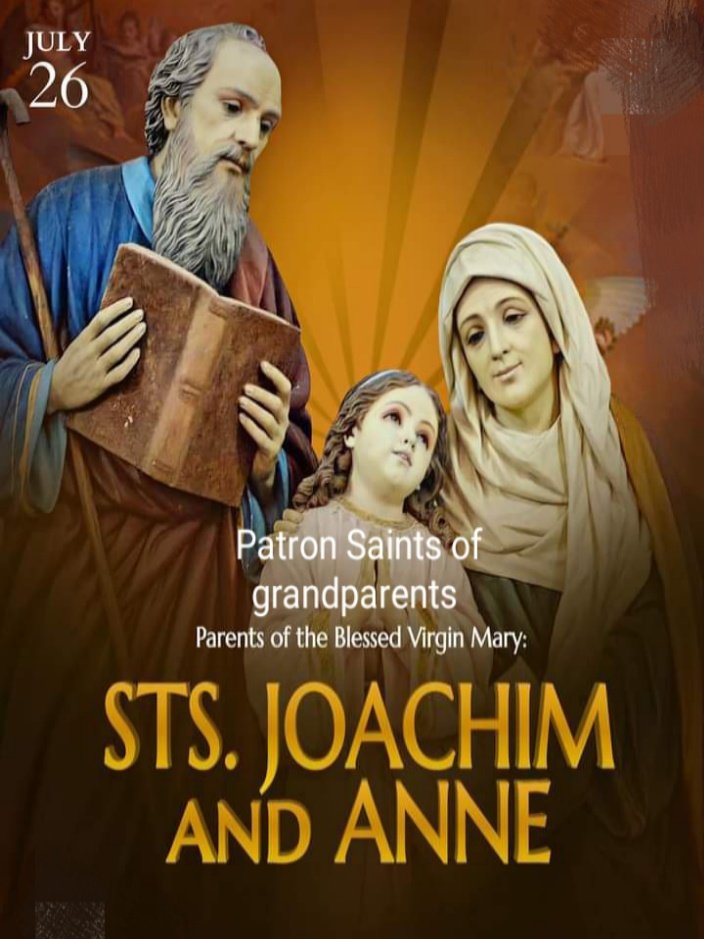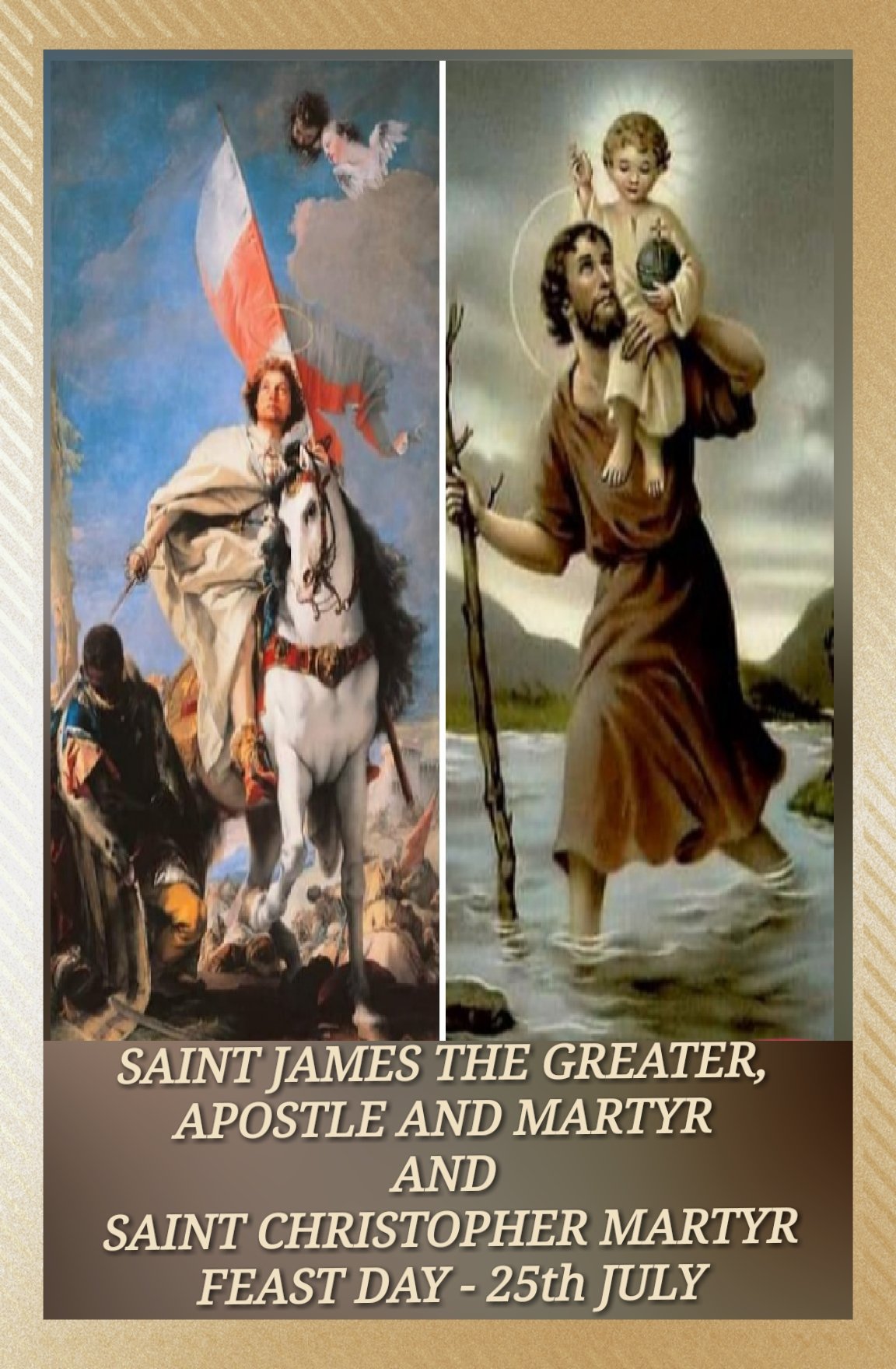
Isaiah 43: 18-19
January 14, 2023
Romans 8:26
January 15, 2023FEAST OF SAINT PAUL OF THEBES (PAUL THE HERMIT), SAINT ITA OF KILLEEDY, SAINT NINA
FEAST DAY – 15th JANUARY
Paul of Thebes, commonly known as Paul, the First Hermit or Paul the Anchorite, c. 227 – c. 341, was an Egyptian saint regarded as the first Christian hermit, who was claimed to have lived alone in the desert of Egypt from the age of sixteen to the age of one hundred and thirteen years old. He is venerated as a saint by the Catholic Church as well as the Eastern Orthodox Church and Oriental Orthodox Churches.
Paul the Hermit should not be confused with St Paul the Apostle. St Paul the Hermit is traditionally considered as the first saint living the solitary life.
He was born around the year 228 in Alexandria, Egypt, of wealthy and noble parents.The Life of Saint Paul the First Hermit was composed in Latin by Saint Jerome, probably in 375–376. Paul of Thebes was born around 227 in the Thebaid of Egypt. Paul and his married sister lost their parents. In order to obtain Paul’s inheritance, his brother-in-law sought to betray him to the persecutors. According to Jerome’s Vitae Patrum, Paul fled to the Theban desert as a young man during the persecution of Decius and Valerianus around AD 250.
He lived in the mountains of this desert in a cave near a clear spring and a palm tree, the leaves of which provided him with clothing and the fruit of which provided him with his only source of food until he was 43 years old, when a raven started bringing him half a loaf of bread daily. He would remain in that cave for the rest of his life. Paul of Thebes is known to posterity because around the year 342, Anthony the Great was told in a dream about the older hermit, and went to find him.
Jerome related that Anthony the Great and Paul met when the latter was aged 113. They conversed with each other for one day and one night. The Synaxarium shows each saint inviting the other to bless and break the bread, as a token of honor. Paul held one side, putting the other side into the hands of Father Anthony, and soon the bread broke through the middle and each took his part. When Anthony next visited him, Paul was dead. Anthony clothed him in a tunic which was a present from Athanasius of Alexandria and buried him, with two lions helping to dig the grave.
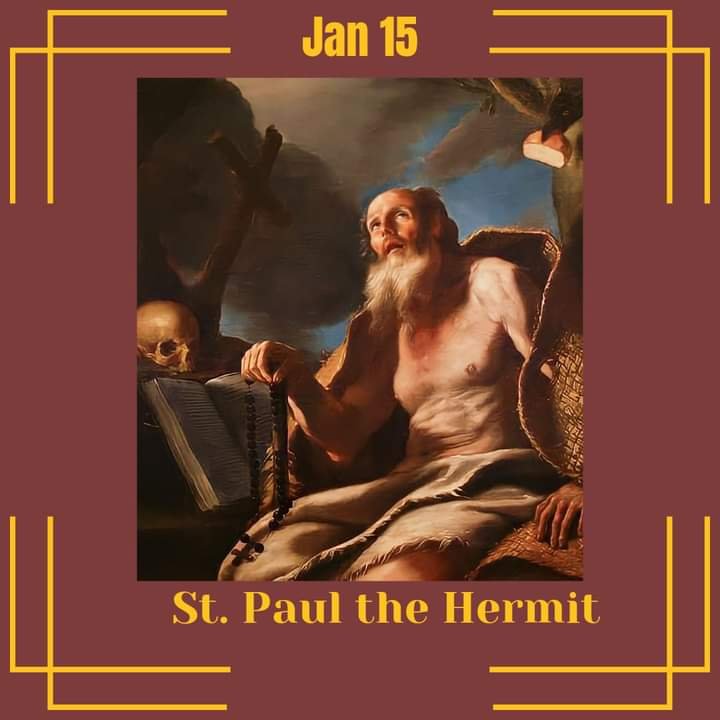
Father Anthony returned to his monastery taking with him the robe woven with palm leaf. He honored the robe so much that he only wore it twice a year: at the Feast of Easter, and at the Pentecost. His feast day is celebrated on 15 January in the West, on 5 January or 15 January in the Eastern Orthodox Churches, and on 9 February in the Oriental Orthodox Churches. Anthony described him as “the first monk”.
The Monastery of Saint Paul the Anchorite is traditionally believed to be on the site of the cave where Paul lived and where his remains are kept. The monastery is located in the eastern desert mountains of Egypt near the Red Sea. The Cave Church of St. Paul marks the spot where Anthony, “the Father of Monasticism”, and Paul, “the First Hermit”, are believed to have met.
He is also the patron saint of the Diocese of San Pablo (Philippines) and is the titular of the Cathedral of the said Diocese in San Pablo, Laguna, Philippines. The Order of Saint Paul the First Hermit was founded in Hungary in his honour in the 13th century. He is usually represented with a palm tree, two lions and a raven.
PRAYER
O God, who willed that St. Paul achieve a high degree of sanctity through a life of solitude, prayer and penance in the desert, grant that through his intercession, we, who are striving to develop in ourselves the spirit of prayer and service, may come ever closer to you in love. We ask this through Christ our Lord. Amen

Saint Paul, pray for us.
+±++++++++++++++++++++++++++++++++
FEAST OF SAINT ITA OF KILLEEDY
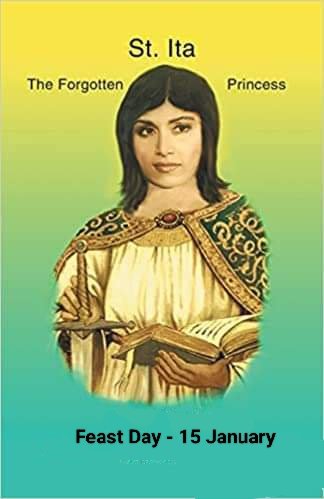
Today, January 15, we celebrate the feast of Saint Ita (also known as Saint Deirdre or Saint Mida, 475-570), nun, teacher, miracle-worker, and “Foster Mother” to the Irish Saints. Second only to Saint Brigid among the ancient Irish female saints, Saint Ita served the Lord through teaching and forming many other Catholic saints. She is widely venerated throughout Ireland—even one of the professional football teams is named for her, with her image appearing on their crest!
Saint Ita, born and baptized Deirdre, was born at Decies, Waterford (in Ireland), of royal lineage. From a young age, she felt drawn to serve the Lord, and while still a child, consecrated herself in virginity to Jesus. Her father wished her to be married, however, and arranged a potential suitor which would make good political sense. Deirdre, for her part, refused to marry, however.
She fasted for three days, praying constantly to God, and on the third day, her father was visited by an angel in a dream, following which he understood the important holy role his daughter was to play. Upon awakening, he offered his blessing to Ita, who moved to Killeedy, Limerick and pursued a life of holy virtue.
Deirdre took the name Ita, which means “thirst for Divine Love,” and after taking the veil, founded a community of nuns at Hy Conaill, in County Limerick. The convent quickly swelled, with many flocking to become a member of her community.
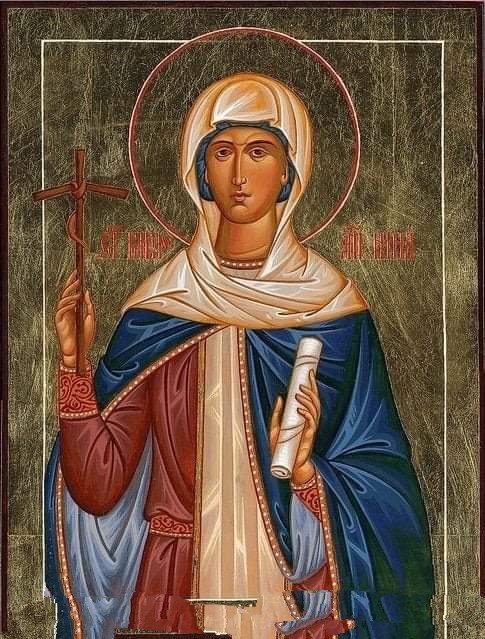
Saint Ita lived an extremely austere life, fasting rigorously, and modeling humility, patience, and obedience to her charges. So committed to poverty, it is said that once, when a rich man pressed gold on her, she immediately sent for water to wash her hands.
She enacted the harshest bodily mortifications. Saint Ita established a school for boys in Killeedy, with many saintly students—including Saint Fachtna of Ross, Saint Pulcherius of Liath, Saint Cummian of Clonfert, and Saint Brendan the Voyager—learning from her. According to holy legend,
When Saint Brendan asked Saint Ita what three things were most pleasing to God, she replied, “True faith in God with a pure heart, simple life with a religious spirit, and open handedness inspired by charity.” “And what three things,” the child, Saint Brendan, continued, “does God most dislike?” Saint Ita is said to have replied, “A face which scowls upon all mankind, obstinacy in wrongdoing, and an overweening confidence in the power of money.”
Saint Ita is reported to have performed extravagant miracles, including re-attaching the severed head of a decapitated man, and living for years solely from food delivered directly from heaven. Saint Ita gained a reputation for prophecy, and many came from all over the Isles to seek her advice, counsel, and spiritual direction.
Saint Ita is also said to have been visited by an apparition of the Baby Jesus, at which time she penned an Irish lullaby to the Jesukin, still sung today. She is further remembered for her kindness. In one such legend, emphasizing her kind spirit, Saint Ita is said to have allowed a beetle (which was feeding on the flesh of the dead in the cemetery) to instead feed upon her body so that those who had lost family members would not be tormented by the disrespect of their remains. The beetle is said to have devoured much of her side, growing to the size of a small suckling pig over time!
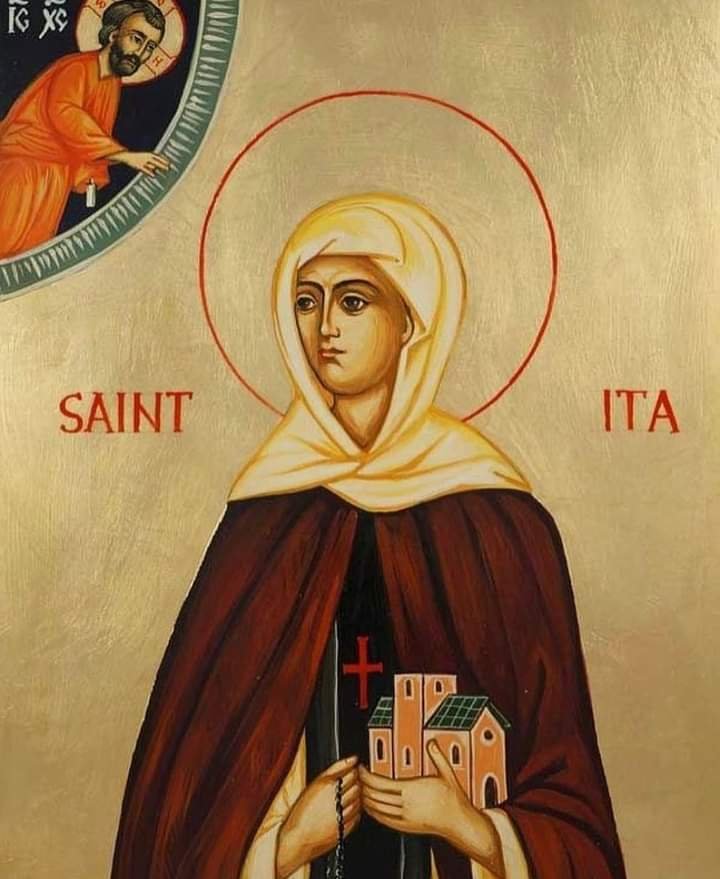
Saint Ita’s Cross
The symbol of Saint Ita is a cross with a heart at the center of a small labyrinth. “As Ita saw it, there is only one way we can marry our hearts to the love of Christ: We must take our hearts, our innermost thoughts and feelings, and move them ever more deeply into the heart of the cross.
Thus, as the wheel of humanity is formed through Christ, through whom all things were made, we spiral from the outermost rim, where we dwell with our concerns about the world, and urge our hearts to the center as we gradually replace our worldly thought and feelings with the desire for Wisdom.
It is this centering prayer that leads us to the heart of the cross. In the heart of the cross we find our own hearts, for they too have been created by God, have been redeemed by Christ, and are continually sustained by the Holy Spirit.” (from allsaintsbrookline.org)
Saint Ita died in her nineties, following the exact prediction of time and place of her death. She was buried in the Church cemetery at Killeedy, where her grave is venerated today. While the monastery lies in ruins, tradition dictates that flowers are brought to cover her grave—a tradition that is still followed by faithful pilgrims today.
PRAYER
Heavenly Father, we are grateful for holy women like Saint Ita who can be such an inspiration to young men and women today. Through her pious life and teachings, many others were influenced to live holy lives and also become saints. May we all strive to lead lives that inspire others to holiness. In the name of Jesus we pray. Amen
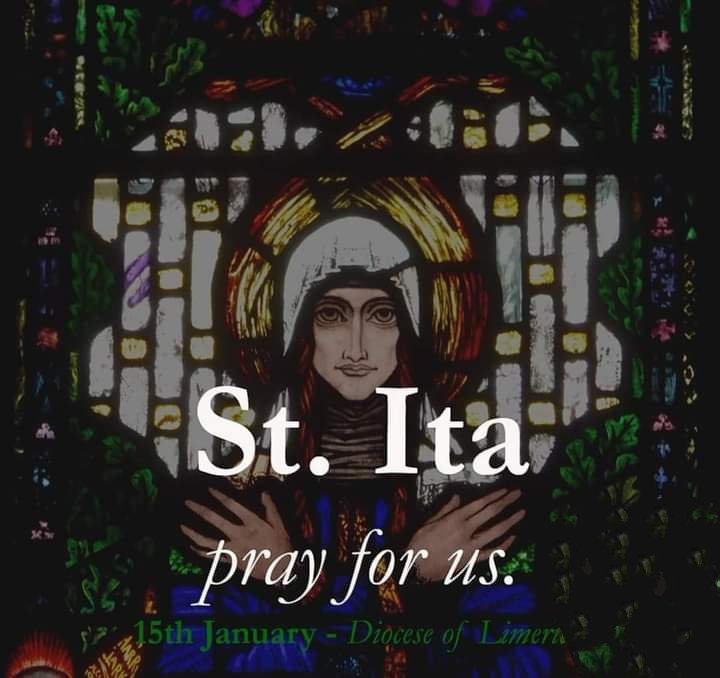
+++++++++++++++++++++++++++++++++++
FEAST OF SAINT NINA OF GEORGIA
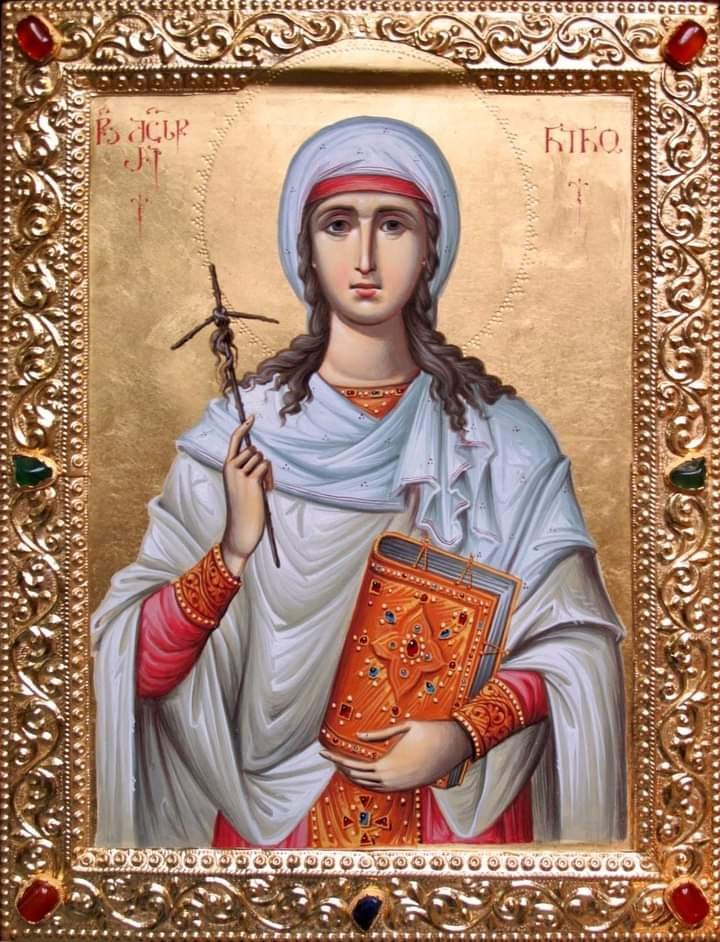 St. Nina was born in Cappadocia, what is now modern day Turkey. She was the only daughter of a Roman General. When Nina was twelve, her family traveled to Jerusalem, where her father became a monk, her mother became a Church worker, and Nina became the foster child of a pious elderly woman. Under her foster mother, Nina quickly learned the rules of faith and piety.
St. Nina was born in Cappadocia, what is now modern day Turkey. She was the only daughter of a Roman General. When Nina was twelve, her family traveled to Jerusalem, where her father became a monk, her mother became a Church worker, and Nina became the foster child of a pious elderly woman. Under her foster mother, Nina quickly learned the rules of faith and piety.
At the age of fourteen, Nina questioned her mentor about the location of Christ’s robe. She was convinced that such an important relic could not have been lost. Her foster mother told her that it was in Iberia, now modern day Georgia, and a land not yet completely developed. When he Apostles had drawn lots to determine who was to preach where, the Mother of God had received the lot of Iberia, but she had been held back from going and was assured that someone would later preach there.
In a dream the Mother of God came to Nina and urged her to preach the Gospel in Georgia. The Mother of God assured Nina that she would protect her and as a pledge, left a cross with her, a cross made of grape vines. The Patriarch, her uncle, was delighted with the news of her vision. He eagerly gave Nina his blessing to go.
When the time arrived for her departure, Nina was led into the Church and was prayed over by the Patriarch these words, “Lord God, Our Savior! As I let this young girl depart to preach Thy Divinity, I commit her into Thy hands. Condescend, O Christ God, to be her Companion and Teacher everywhere that she proclaims Thy Good Tidings, and give her words with such force and wisdom that no one will be able to oppose or refute them.
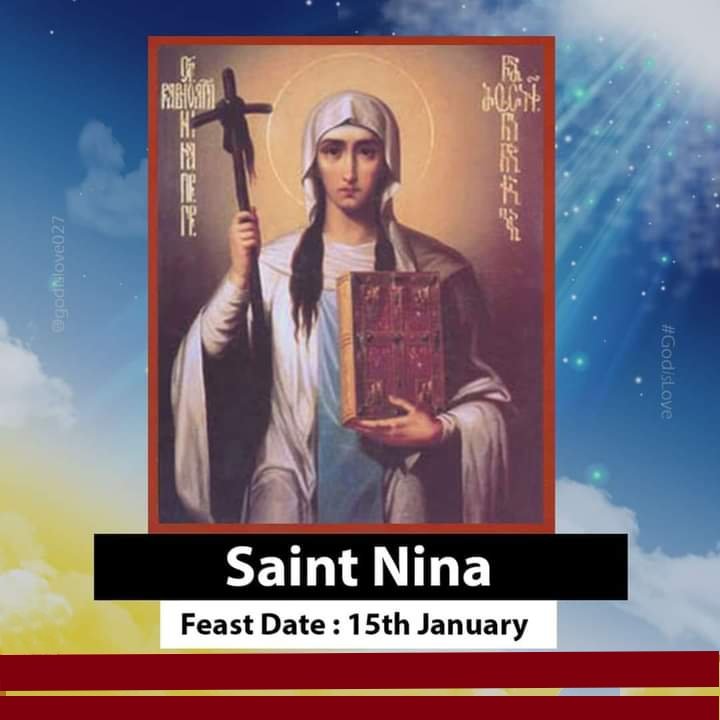
And Thou, most Holy Virgin Mother of God, Helper and Intercessor for all Christians, clothe with Thy strength against all enemies, visible and invisible, this girl whom Thou Thyself hast chosen to preach the Gospel of Thy Son and our God among the pagan nations. Be always for her a shield and an invincible protection, and do not deprive her of Thy favor until she has fulfilled Thy holy will”.
Nina joined the party of Princess Ripsimia, because they were traveling to Georgia to escape the persecution of Diocletian. All but Nina were martyred in Armenia after Ripsimia declined to marry the King. Living as a pilgrim, Nina became weary, and wondered briefly where she was going, and what she was doing. She had continued visions to encourage her on her way. She witnessed the worship of the local gods, and prayed that they might be destroyed. She witnessed a downpour that washed the idols into the river and out of sight.
She settled in the capital where she lived in a hut near the royal garden. She gained a reputation for holiness because of her daily piety and her miraculous healings. She cured Queen Nana of a disease no doctor had been able to relieve. Even the King was converted.
After preaching to and converting many Jews and pagans, Nina learned the story of Christ’s robe. A local Jew, Elioz, had obtained the robe from the soldier to whose lot it had fallen and had carried it home to Georgia. His sister, Sidonia, had clasped the robe to her breast and had died. No one could take the robe from her, and it had been buried with her.
A cedar, now part of the royal garden, was said to have grown from her grave. Nina had doubts about the identification of the particular tree, but she knew from her visions that the ground of the royal gardens was holy. Without knowing that was the location of Christ’s robe, it is where she settled in a hut – in the royal gardens, only to find out later that she was living on the spot where Christ’s robe was buried.
Nina died in the early fourth century, after she had seen Christianity spread throughout Georgia, and had through her preaching, converted a neighboring Queen and her kingdom. Nina was buried near the place where she had died, in Bodbi. The Church built by her grave was dedicated to St. George.
Nina was a pious child who was fostered by another mother, other than her own. She dedicated her life to learning about Christ. She was intrigued as to the whereabouts of Christ’s robe, knowing it was too holy to have been lost. The Mother of God appeared to her and told her it was taken to Georgia, and was asked to go there and convert that nation. She did as she was told, and converted that region.
Once there, she learned that a soldier had brought it back to Georgia after the crucifixion, and had given it to his sister to safe guard. While clutching it to her breast – she died, and no one was able to take it from her. The robe of Christ was buried with her. This very spot was the place that St. Nina had settle as a pilgrim in a hut, without knowing the importance of where she settled. It is said that a cedar grew from the grave of the girl that was buried with Christ’s robe.
